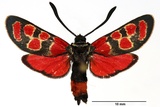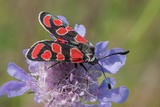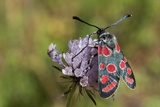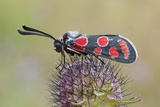Zygaena carniolica (Scopoli, 1763) Species
Last modified: Nov. 21, 2025, 5:35 p.m.
In Belgium, this very rare and local species is only known from some localities in two southern provinces. Populations can fluctuate considerably from year to year.
Nowadays, only observations at the most southern tip of LX and the species is at the brink of extinction in our country (latest observations 2021!).
Details
- Classification
- Family: Zygaenidae > Subfamily: Zygaeninae > Genus: Zygaena > Subgenus: Agrumenia > Species: Zygaena carniolica
- Vernacular names
- Oogvlek-sint-jansvlinder (NL), Zygène du Sainfoin (EN), Zygène de Carniole (FR), Esparsetten-Widderchen (DE)
- First mention in Belgium
- Lambillion L.-J. 1900–1913. Catalogue des Lépidoptères de Belgique. — Revue mensuelle de la Société entomologique namuroise Supplément: 1–464. On page 378.
- Status
-
Native
Distribution
Caterpillar
The larva is light green colored with a series of triangular black spots on the sides of the body.
Cocoon/pupa
The pupae are black-brown, with a white or yellowish ovoid cocoon.
Bionomics
The larvae live freely on the leaves of the food plant and hibernates, potentially multiple times. The cocoons are partly spun at straws, but the majority are hidden near the ground in the litter.
The adults are active during the day. This species is noted for its late afternoon aggregations, so-called parking stations in large numbers on flowers and other elevated plant parts.
Flight periods
The adults fly mainly in July till early August in one generation a year.
Observed on
- Host plant (species):
- Lotus corniculatus
- Host plant (genera):
- Anthyllis, Dorycnium, Onobrychis and Lotus
The oligophagous larva lives on Fabaceae like Lotus species such as Lotus corniculatus and Onobrychis species. Also on Dorycnium and Anthyllis.
Habitat
It occurs on sun-exposed limestone grasslands, dry areas, steppe slopes, dry pastures and locally on clearings in bright woodlands. Because of the long larval development time, reproduction habitats are almost exclusively southeast to southwest exposed.





